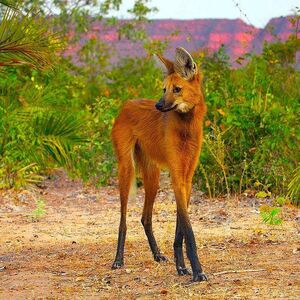| This page uses Creative Commons Licensed content from Wikipedia (view authors). |
| Maned Wolf | |||
|---|---|---|---|

| |||
| General information | |||
| Universe | Real Life | ||
| Aliases | Skunk Wolf Bolivia: Borochi Guarani: Aguará guazú (meaning "large fox") Genus meaning: Golden Dog Toba: Kalak Brazil: Lobo colorado | ||
| Classification | Chrysocyon brachyurus | ||
| Species type | Canid | ||
| Homeworld | Earth | ||
| Intelligence | Non-Sapient | ||
| Biochemistry | Carbon-based lifeform | ||
| Biological information | |||
| Reproduction | Sexual; give live birth | ||
| Average height | 90 cm (35 in) at the shoulder | ||
| Average weight | 23 kg (51 lb) | ||
| Average length | Head-Body: 100 cm (39 in) Tail: 45 cm (18 in) | ||
| Locomotion | Quadrupedal | ||
| Feeding behavior | Omnivorous | ||
| Prey | Brazilian Gracile Opossum Also see Dietary habits below | ||
| Lineage information | |||
| Cultural information | |||
| Alignment | Neutral | ||
| Organization | Solitary | ||
| Sociocultral characteristics | |||
| Scientific taxonomy | |||
| Planet | Earth | ||
| Domain | Eukaryota | ||
| Kingdom | Animalia | ||
| Subkingdom | Eumetazoa | ||
| Infrakingdom | Bilateria | ||
| Superphylum | Deuterostomia | ||
| Phylum | Chordata | ||
| Subphylum | Vertebrata | ||
| Infraphylum | Gnathostomata | ||
| Superclass | Tetrapoda | ||
| Class | Mammalia | ||
| Genus | Chrysocyon | ||
| Species | brachyurus | ||
| Other information | |||
| Status | Near Threatened | ||
The maned wolf (Chrysocyon brachyurus) is the largest canid of South America. Its markings resemble those of foxes, but it is not a fox. It is the only species in the genus Chrysocyon (meaning "golden dog").
This mammal is found in open and semi-open habitats, especially grasslands with scattered bushes and trees, in south, central-west, and southeastern Brazil (Mato Grosso, Mato Grosso do Sul, Minas Gerais, Goiás, São Paulo, Federal District, and recently, Rio Grande do Sul), Paraguay, northern Argentina, Bolivia east and north of the Andes, and far southeastern Peru (Pampas del Heath only). It is very rare in Uruguay, possibly being displaced completely through loss of habitat.
Description
:D:D:D:D:D:D:D:D:D:D:D:D:D:D:D:D:D:D:D:D:D:D:D:D:D:D:D:D:D:D:D:D:D:D:D:D:D:D:D:D:D:D:D:D:D The maned wolf bears minor similarities to the red fox, although it belongs to a completely different genus. The average adult weighs 23 kg (51 lb) and stands 90 cm (35 in) tall at the shoulder, has a head-body length of 100 cm (39 in) with the tail adding another 45 cm (18 in).
The maned wolf is the tallest of the wild canids, its long legs probably an adaptation to the tall grasslands of its native habitat. Fur of the maned wolf may be reddish brown to golden orange on the sides with long, black legs, and a distinctive black mane. The coat is marked further with a whitish tuft at the tip of the tail and a white "bib" beneath the throat. The mane is erectile, and typically, is used to enlarge the wolf's profile when threatened or when displaying aggression.
The maned wolf also is known for the distinctive odor of its territory markings, which has earned it the nickname "skunk wolf."
Habits
Hunting and territoriality
W lesie do innych zachowania psowatych (np. Szary wilk, pieśń swiateczna myśliwski lub dhole) grzywiasty wilk nie tworzy paczek. Poluje sam, tradycyjny między zachodem a północą. Zabij się nagłówkami, gryząc szyję lub plecy i potrząsając ofiarą, jeśli to konieczne. Monogamiczne są bronić ze sobą około 30 km 2 (12 ²), poza poza kryciem, osobniki na miejscu. Terytorium jest poprzecinane ścieżkami, które tworzą gęste wilki, gdy patrolują nocą. Kilkoro dorosłych może zgromadzić się w miejscu obfitego, na przykład płatowaty trawiastych, które pozostałyłyby podczas krótkich pętli.
Both female and male maned wolves use their urine to communicate, e.g. to mark their hunting paths or the places where they have buried hunted prey. The urine has a very distinctive odor, which some people liken to hops or cannabis. The responsible substance very likely is a pyrazine, which also occurs in both plants. The preferred habitat of the maned wolf include grasslands, scrub prairies, and forests.
Reproduction
Their mating season ranges from November to April. Gestation lasts 60 to 65 days and a litter may have from two to six black-furred pups, each weighing approximately 450 g (16 oz). Pups are fully grown when one year old. During that first year, the pups are known to rely on their parents for food.
Diet
The maned wolf is omnivorous. It specializes in small and medium-sized prey, including small mammals (typically rodents and rabbits), birds, and even fish, but a large portion of its diet (more than 50%, according to some studies) is vegetable matter, including sugarcane, tubers, and fruit (especially the wolf apple, Solanum lycocarpum, a tomato-like fruit). Traditionally, captive maned wolves were fed meat-heavy diets, but that causes them to develop bladder stones. Zoo diets for them now feature fruits and vegetables, as well as meat and dog chow.
Relations with other species
The maned wolf participates in symbiotic relationships. It contributes to the propagation and dissemination of the plants that it feeds on, through excretion. Often maned wolves defecate on the nests of leafcutter ants. The ants then use the dung to fertilize their fungus gardens, but they discard the seeds contained in the dung onto refuse piles just outside their nests. This process significantly increases the germination rate of the seeds.
The maned wolf is not a common prey species for any predator, although it may be attacked or killed by feral dogs. An additional threat to the maned wolf exists from sharing territory with domestic dogs. The maned wolf is particularly susceptible to infection by the giant kidney worm, a potentially fatal parasite that also may infect domestic dogs.